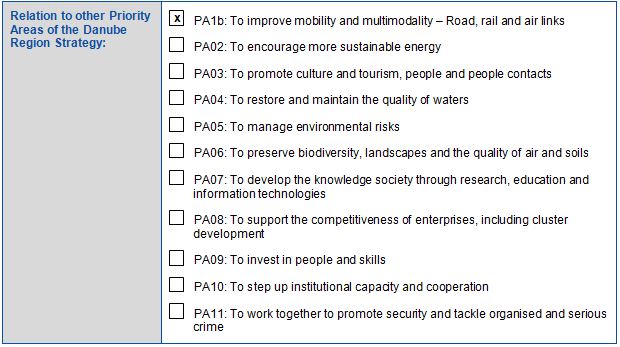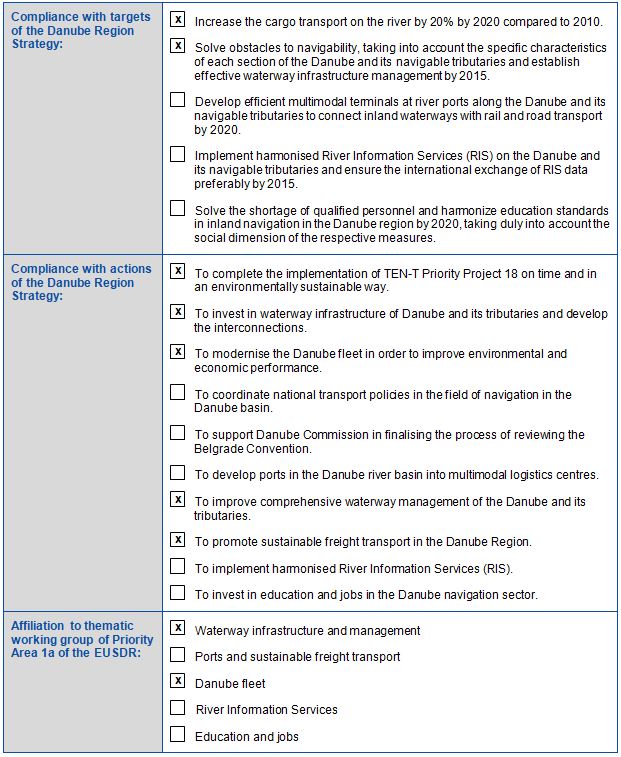BASIC PROJECT DATA
Project ID: PA1A143
NEED AND ADDED VALUE FOR THE DANUBE REGION STRATEGY
The movement of freight is the most important economic use of the Danube, Europe’s second-longest river. Solving the obstacles to navigability, taking into account the specific characteristics of each section of the Danube and its navigable tributaries and establishing effective waterway infrastructure management by 2020 is among the targets of Priority Area 1a of the European Union Strategy for the Danube Region.
OBJECTIVE(S) OF THE PROJECT
Fairway marking is an essential activity for navigational safety and accident prevention that defines the navigability conditions of a certain river section. Traffic along the shipping route is controlled by land- and waterside navigation signs. The landside navigation signs are mainly located on the riverbanks or mounted on hydraulic structures and serve the interpretation of traffic rules. The marking of the fairway trajectory and of characteristic points along the route is done with buoys (floating navigation signs). Placing the buoys according to the current riverbed morphology is the main objective of fairway marking activities. The fairway marking signs are to be checked continuously due to the fluctuation of the water level and the riverbed changes, and if necessary they are to be re-positioned or re-placed. The former fairway marking system, especially with respect to floating navigation signs, needed modernization. The marks were to be modernized and the operational tasks were to be improved, especially with respect to cost-efficiency. In order to make navigation safer, modern buoys (unlighted and light buoys) with better characteristics (low-maintenance, higher stability in currents and ice drifts, better visibility and resistance to damage) were to be applied.
The improvement of the fairway marking system included a modern buoy system as well as landside bank marks and fits well into the traffic safety system of the 3,300 km long Danube-Main-Rhine inland waterway. Furthermore, it is in full adherence to the relevant legislation. The marking should define the fairway trajectory in such a way that the vessels can follow it safely with their compulsory navigational tools. The completed fairway marking system for the Hungarian Danube section includes about 1,500 land- and waterside navigation signs, ships and their staff operating the vessels and the equipment. The operational tasks can only be executed with ships equipped with modern riverbed surveying tools and equipment that allows for the positioning of marking signs. Within the project at hand, three full-functional vessels and three high-speed inspection boats were procured.
The improvement of the fairway marking tasks and system, from a technical perspective, was independent from other activities aiming at the improvement of the fairway parameters. There is a need to improve the current fairway marking system, especially for the present status of the river. The development of the complete waterway is executed according to the recommendations of the Danube Commission, based on the Belgrade Convention and the parameters of the AGN agreement.
Specific objectives of the project:
- Modernisation of the fairway marking fleet for more efficient and environmentally-friendly marking operations
- Modernisation of the marking system (buoys) to improve navigability
PLANNED PROJECT ACTIVITIES
The Action entails 9 activities from the preparation of the tender documentation to the installation/deployment of the fairway marking signs, including their testing.
- Activity 1 – Preparing tender documents
Elaborating the technical specifications of the public procurement documentation for vessels (marking vessel, fast-response boat) and buoys, landside navigation signs and other marks. The public procurement documentation of both vessel types is to contain specifications of the instruments, like surveying tools and equipment for placing the buoys.
Procurement documentation and specifications are to be made for the buoys and landside navigation signs below:- floating light buoys (AIS AtoN buoys, regular light buoy)
- floating unlighted buoys,
- bank marks (AIS AtoN mark, regular mark)
- river km marks
- Activity 2 – Public procurement (designing and manufacturing of vessels, procurement of boats)
- Activity 3 – Public procurement (bank markers, intelligent floating markers, monitoring system, selection of type of unlighted buoys, procurement)
- Activity 4 – Procurement delivery
- Activity 5 – Deployment, installation
- Activity 6 – Test run of the fairway marking system
The different parameters of the fairway marking signs and the various characteristics of certain signs are specified by legislation. The signs to be procured must meet these guidelines. Of course, the actual conditions at certain river sections need to be taken into. Navigation signs fully corresponding with the guidelines may not correspond with the actual local conditions. During the test run of the system these possible faults can be corrected.
Following the placement and commissioning of buoys, the navigation signs need to be observed continuously – similarly to a test run. The optimal test run duration for the floating navigation signs is about a year. In this period the different weather conditions of the seasons and their impact on the marking system can be observed.
During the commissioning of landside marks, the remote position monitoring will also be established. At the end of the test run, after establishing safe operation of the new fairway marking system, the shipping authority issues the operational licence. - Activity 7 – Establishment of data transmitting system
It is necessary to establish a data transmitting system for the operation of the AIS buoys and the AIS riverbank marks which is capable of receiving and processing data on the exact position of every single AIS buoy (signal transmitted by the intelligent buoys). This information should be made available to ships’ captians directly on board of vessels in the area and to the waterway administration responsible for fairway marking. - Activity 8 – Project management
- Activity 9 – Other services
Services for public relations activities as well as the services for auditing and public procurement are provided via framework contracts signed by ‘NIF Zrt.’ This includes the supervision and the support of training activities concerning the new tools and equipment and the costs for photocopying, translation and other supportive activities.
TRANSBOUNDARY IMPACT
Every state along the Rhine-Danube Corridor will be positively affected by better conditions for navigation.
PROJECT BENEFICIARIES / TARGET GROUPS
The users of the waterway are the main beneficiaries of the project.
STATUS AND TIMEFRAME
Start date: September 2015
End date: May 2020
This project has already been concluded.
FINANCING
Total budget: EUR 8,919,872
EU funds: EUR 7,581,891.20 are funded by Connecting Europe Facility (CEF) 2014 – 2020
National funds: EUR 1,337,980.80
PROJECT TEAM
Project beneficiary: Hungarian Ministry of National Development
(website: http://www.kormany.hu/hu/nemzeti-fejlesztesi-miniszterium)
Address: Fő utca 44-50, 1011 Budapest / Hungary
Contact person: Beatrix Horváth (Ministry of National Development – Head of CEF Department)
Contact data:
Implementing bodies:
- National Infrastructure Development Private Company Limited
- General Directorate of Water Management
PROJECT ENVIRONMENT
PROJECT CROSS – REFERENCE
FAIRway Danube (PA1A108)
STRATEGIC REFERENCE
The project at hand supports the EU Cohesion Policy and the TEN-T cohesion objectives at various levels. On the one hand, it reduces disparities between the qualities of transport infrastructure of the member states; on the other hand, it improves the long-distance and regional transport connections. With the improved competitiveness of the EU, the intervention indirectly contributes to the creation of new jobs. In the respective corridor, the waterway traffic and transport will become safer, more competitive and attractive. With the expansion of environmentally-friendly inland waterway transport (lower CO2 emission rate) sustainable growth is facilitated, which is an objective of the Europe 2020 Strategy (20% decrease in GHG emissions, 20% energy efficiency improvement).
RELEVANT LEGISLATION
- TEN-T Regulation (EU) No. 1315/2013 on Union guidelines for the development of the trans-European transport network (TEN-T Regulation), which requires Member States to upgrade a so-called TEN-T Core Network by 2030, so that minimum requirements for the transport infrastructure are fulfilled.
- International legislation is based on the Danube Commission recommendations “Instruction for installation of signs of fairway buoyage and marking system on the Danube”, ed. 2006 and ECE Guidelines for Waterway Signs and Marking (Resolution No. 59 – ECE/TRANS/SC.3/169/Rev.1). National legislation is No. 27/2002 GKM regulation for establishment, operation, modification and termination of waterway signs and marking.
EUSDR EMBEDDING
EUSDR COMPLIANCE
OTHER RELEVANT ISSUES
PROJECT REQUIREMENTS
The beneficiary of the project is the Ministry of National Development (NFM). The CEF-Department under the Deputy State Secretariat for Transport Operational Programmes is responsible for the management, preparation and implementation of CEF projects. According to Article 2.11 of the CEF-Regulation when the beneficiary is a Member State, it may designate a public or private undertaking or body to implement the action concerned.
Under this project two implementing bodies have been designated with clearly identified tasks and responsibilities:
- National Infrastructure Development Co. Ltd. (NIF Zrt.) which is a fully state-owned organisation and NFM’s background organisation responsible for infrastructure development
- General Directorate of Water Management (OVF) which is an independently operating body, reporting to the Minister of Interior Affairs (BM) and financed from the government budget, with national competence.
The coordinating implementing body of the project is NIF Zrt. (PM organisational framework is ensured by NIF Zrt.). Among others, it performs administrative tasks and fulfils the obligations associated with the assistance. OVF basically delivers its opinion on professional issues, makes decisions and approves them through its competent representatives delegated to the PM, who are also responsible for professional management and control of the performance by the contractor as well as preparation of the professional specifications for public procurements. The framework of cooperation within the project is laid down in the agreement between the two organisations.
Most critical issue is the cooperation and coordination of the implementing bodies (NIF, OVF) by NFM CEF-Department. Without a cooperation agreement, public procurement procedures cannot be started.
META DATA
Data provided by: Kötél Pál (EDUVIZIG / Hungary) – 14.11.2016
Download pdf



